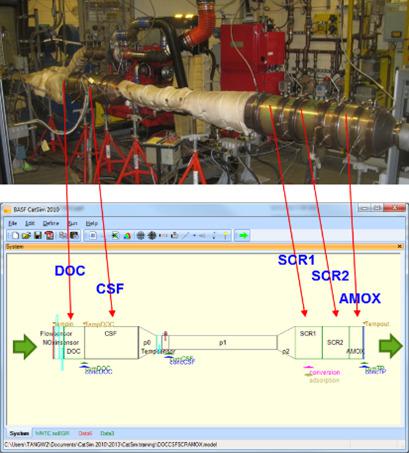当前位置:
X-MOL 学术
›
Chem. Eng. Technol.
›
论文详情
Our official English website, www.x-mol.net, welcomes your
feedback! (Note: you will need to create a separate account there.)
Urea Decomposition and Implication for NOx Reduction with Cu‐Zeolite and Vanadia‐Selective Catalytic Reduction
Chemical Engineering & Technology ( IF 1.8 ) Pub Date : 2020-06-22 , DOI: 10.1002/ceat.202000036 Yi-Jiang Wu 1 , Fengshuang Wang 2, 3 , Weiyong Tang 1 , Ramesh Kakwani 1 , Yaling Hou 2, 4 , Gang Feng 2, 4
Chemical Engineering & Technology ( IF 1.8 ) Pub Date : 2020-06-22 , DOI: 10.1002/ceat.202000036 Yi-Jiang Wu 1 , Fengshuang Wang 2, 3 , Weiyong Tang 1 , Ramesh Kakwani 1 , Yaling Hou 2, 4 , Gang Feng 2, 4
Affiliation

|
Understanding urea decomposition is critical to achieve highly efficient selective catalytic reduction (SCR). The urea decomposition process in an exhaust pipe and in Cu‐zeolite and vanadia‐SCR (V‐SCR) was studied in engine test cells. The unconverted urea at the SCR inlet can be substantial at lower temperatures. HNCO and NH3 are two dominant products at the SCR inlet. Urea and HNCO continue to decompose in SCR catalysts, with a rate much faster than in the homogeneous stream. The HNCO hydrolysis process is extremely efficient in Cu‐zeolite SCR and the abundant NH3 from urea overdosing can improve the NOx conversion efficiency. While for V‐SCR, the HNCO hydrolysis reaction can become the rate‐limiting step (especially after aging), abundant urea at low temperatures impairs NOx reduction.
中文翻译:

铜沸石和钒选择性催化还原的尿素分解及其对NOx还原的意义
了解尿素的分解对于实现高效的选择性催化还原(SCR)至关重要。在发动机测试室中研究了排气管,Cu沸石和vanadiaSCR(VSCR)中尿素的分解过程。在较低的温度下,SCR入口处未转化的尿素可能会很大。HNCO和NH 3是SCR入口处的两个主要产物。尿素和HNCO在SCR催化剂中继续分解,其分解速度比在均相流中快得多。HNCO水解过程在Cu-沸石SCR中非常有效,过量添加尿素产生的大量NH 3可改善NO x转换效率。而对于V-可控硅,HNCO水解反应可成为在低温下也妨碍NO的限速步骤(特别是在老化之后),丰富的尿素X还原。
更新日期:2020-06-22
中文翻译:

铜沸石和钒选择性催化还原的尿素分解及其对NOx还原的意义
了解尿素的分解对于实现高效的选择性催化还原(SCR)至关重要。在发动机测试室中研究了排气管,Cu沸石和vanadiaSCR(VSCR)中尿素的分解过程。在较低的温度下,SCR入口处未转化的尿素可能会很大。HNCO和NH 3是SCR入口处的两个主要产物。尿素和HNCO在SCR催化剂中继续分解,其分解速度比在均相流中快得多。HNCO水解过程在Cu-沸石SCR中非常有效,过量添加尿素产生的大量NH 3可改善NO x转换效率。而对于V-可控硅,HNCO水解反应可成为在低温下也妨碍NO的限速步骤(特别是在老化之后),丰富的尿素X还原。










































 京公网安备 11010802027423号
京公网安备 11010802027423号